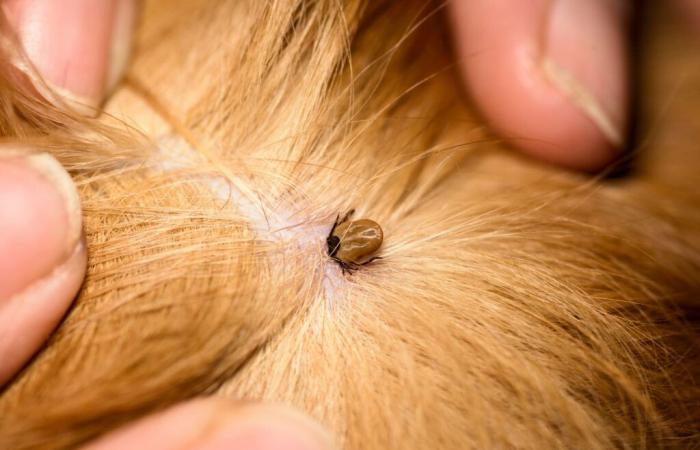Why do ticks gain from land in 2025?
Global warming, the evolution of ecosystems and the decrease of certain natural predators promote the proliferation of ticks. According to the latest veterinary studies published in March 2025, previously spared departments now record a strong resurgence.
In addition, the most widespread tick, Ixodes ricinusvector of many diseases, is now active earlier in the spring and later in autumn, increasing the exposure period.
What diseases your Does dog risk?
Ticks can transmit several dangerous diseases for your dog:
- La PiPlasmose : destruction of red blood cells, vital veterinary emergency.
- Lyme disease : joint pain, fever, cardiac involvement possible.
- L’ehrlichiose : coagulation disorders, fever, weight loss.
- L’os anaplasmose : bacterial infection affecting the immune system.
A single bite may be enough to infect your peteven if the tick did not remain hung for a long time.
Map of new areas at risk in 2025
According to the latest data published by the Association for the Study of the Epidemiology of Animal Diseases (AEEMA) in April 2025, here are the French areas where Vigilance must be reinforced :
| Region / Department | Situation one 2024 | Situation one 2025 |
|---|---|---|
| Brittany (Ille-et-Vilaine, Morbihan) | Low risk | Average risk |
| Pays de la Loire (Loire-Atlantique) | Low risk | High risk |
| Center-Val de Loire (Indre, Cher) | Average risk | High risk |
| Normandy (Calvados, Orne) | Low risk | Average risk |
| Île-de-France (Seine-et-Marne, Yvelines) | Average risk | High risk |
| Nouvelle-Aquitaine (Landes, Gironde) | High risk | Very high risk |
| Auvergne-Rhône-Alpes (Cantal, Allier) | Low risk | Average risk |
Wood wet areas, forest edges and high herbs remain the most conducive environments to the presence of ticks.
How to effectively protect your dog Against ticks?
Faced with the extension of risk zones, rigorous protection becomes essential. Here are the recommended measures:
- Use an appropriate antiparasitic : necklace, pipette or tablet prescribed by the veterinarian.
- Inspect your dog after each walk : In particular the ears, the armpits, the interior of the thighs, the neck and between the fingers.
- Avoid tall grass : favor the paths cleared during walks.
- Vaccinate if necessary : Some veterinarians now offer vaccination against Lyme disease.
Remove a tick must be done with an adapted tick. It should not be never pull suddenly Nor use alcohol or ether, as it increases the risk of infection.
When to consult a veterinarian ?
Even if the bite seems benign, it is advisable to quickly consult a veterinarian If your dog presents in the following days:
- Unusual fatigue.
- Fever.
- A loss of appetite.
- Joint or muscular pain.
- Swelling at the point of bite.
These signs may indicate the beginning of a disease transmitted by the tick. Quick management considerably improves the prognosis.
Increased vigilance is put in 2025
With the extension of ticks to new geographic areas, Prevention becomes the best weapon To protect your dog. By adapting your walks, regularly controlling your pet and using appropriate treatments, you considerably reduce the risks.
In 2025, it is better to start from the principle that Any exit in kind is potentially at riskeven in departments where ticks were once rare. An informed master better protects his companion.








